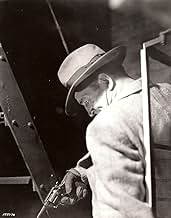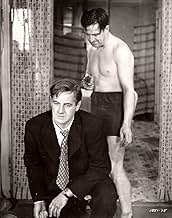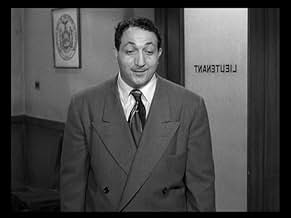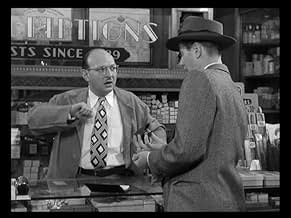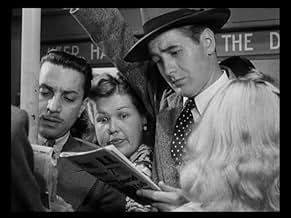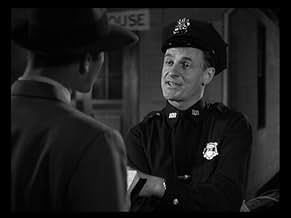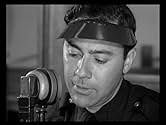IMDb RATING
7.5/10
17K
YOUR RATING
A step-by-step look at a murder investigation on the streets of New York.A step-by-step look at a murder investigation on the streets of New York.A step-by-step look at a murder investigation on the streets of New York.
- Won 2 Oscars
- 6 wins & 5 nominations total
Ted de Corsia
- Willy Garzah
- (as Ted De Corsia)
Mark Hellinger
- Narrator
- (voice)
Jean Adair
- Little Old Lady
- (uncredited)
Celia Adler
- Dress Shop Proprietress
- (uncredited)
Janie Alexander
- Girl
- (uncredited)
Joyce Allen
- Shopgirl
- (uncredited)
Beverly Bayne
- Mrs. Stoneman
- (uncredited)
Featured reviews
Can film noir work in broad daylight - surely a contradiction in terms..? Well, here, it's attempted and largely pulled off by director Jules Dassin with a down-to-earth almost documentary realism which fully involves the viewer in the action as the well-known tag-line "1 of 8,000,000 stories" (the murder of a pretty female immigrant who's fallen into bad company and criminal habits) is played out over a three-day period in a sunny summery New York cityscape. William Daniels' excellent photography captures a city constantly on the move with its own citizens as accidental extras and actual locations as would-be film-sets. Just as effective is the natural vernacular dialogue with some great one-liners thrown in - none better than Barry Fitzgerald seemingly admiring the rear view of a retreating beautiful female suspect with the remark to a junior colleague "Beautiful long legs she has, wouldn't you say?" to which the underling readily concurs only for old pro Fitzgerald to snap "Keep them in sight for the next 48 hours!" detailing a tail on her. There's also another great scene where the murdered girl's mother berates to all and sundry her dead daughter for her reckless lifestyle and bringing of shame onto her family right up until she is taken to identify the corpse where she breaks down uncontrollably, her maternal feelings restored. The murder tale is slightly convoluted but reasonably easy to follow, no contrived clever-clever plotting here, just an everyday relatively uncomplicated murder, solved by routine police work which makes the headlines due to the beauty of the victim. There's close attention paid to forensics and even the insertion of scenes where perennial sad hoaxers come forward to either claim to solve the murder or even confess to it. The acting is mostly good, Fitzgerald is dapper and spot-on as the world-weary 'tec and his supporting officers all acquit themselves well too. The playing however of some of the criminals gets a little overwrought at times and jars the mood slightly. The film arrives at a reasonably exciting conclusion high above Williamsburg Bridge before the city goes back to sleep awaiting its next story... All done and dusted in 90 very watchable minutes, this is a very entertaining film-blanc I suppose you'd have to call it.
An unrealized project of Alfred Hitchcock's was to make a movie about 24 hours in the life of a great city, probably New York. Producer Mark Hellinger enlisted director Jules Dassin to attempt a similar stunt. The result was The Naked City, a slice-of-life police procedural that served as template for the popular television series a decade later. And while the movie is nowhere near the ground-breaking cinematic enterprise that Hellinger promises in his introduction and ceaseless voice-over narration, it's not negligible. With its huge cast (many of them recognizable, even in mute or walk-on roles) and pioneering location shooting on the sidewalks of New York during the sweltering summer of 1947, it nonetheless continues to satisfy. Its documentary aspect outlives its suspense plot.
It opens with two men chloroforming and then drowning a high-profile model in her city apartment (shades of I Wake Up Screaming and Laura). When her cleaning lady finds her next morning, it falls to Detective Lieutenant Barry Fitzgerald, with his heather-honey lilt, and his principal investigator, Don Taylor, to fit the pieces together. Soon into their web flits Howard Duff, an affable, educated loafer with no visible means of support who lies even when the truth would do him no harm. It seems he was on cozy terms with the deceased, even though he's engaged to one of her co-workers (Dorothy Hart). But although Duff's a poor excuse for a human being, nothing seems to stick to him, either. So the police slog on through the broiling day and soupy night, knocking on doors and flashing pictures of the dead girl. Their sleuthing takes them, and us, up and down the hierarchy of the city's eight million souls, from society dames and society doctors to street vendors and street crazies.
While the plot never rises out of the routine, these urban excursions give the movie its raffish texture and remain one of its chief pleasures. This was New York in the dawn of its post-war effloresence, a city where it was still common practice to live comfortably on modest average wages. The gap between East Side apartments and Lower East Side walkups, with the bathtub in the kitchen, doesn't yet seem impossible to cross. And its inhabitants burst on camera with a welter of accents and attitudes. Hellinger and Dassin must have enlisted the services of every character-actor and bit-player in the Tri-State area, and film buffs will have a trivia tournament in trying to pick them out.
The Naked City ends with a chase over hot pavements and a stand-off high up on one of the bridges spanning the East River. It's a great set-piece, of the sort that action movies are all but required to include, but the movie's strength proves more subtle it lies in its collection of sharply drawn vignettes (some of them, to be sure, little more than sentimental shtik). The Naked City is a rarity a major production where the day players outshine the stars.
It opens with two men chloroforming and then drowning a high-profile model in her city apartment (shades of I Wake Up Screaming and Laura). When her cleaning lady finds her next morning, it falls to Detective Lieutenant Barry Fitzgerald, with his heather-honey lilt, and his principal investigator, Don Taylor, to fit the pieces together. Soon into their web flits Howard Duff, an affable, educated loafer with no visible means of support who lies even when the truth would do him no harm. It seems he was on cozy terms with the deceased, even though he's engaged to one of her co-workers (Dorothy Hart). But although Duff's a poor excuse for a human being, nothing seems to stick to him, either. So the police slog on through the broiling day and soupy night, knocking on doors and flashing pictures of the dead girl. Their sleuthing takes them, and us, up and down the hierarchy of the city's eight million souls, from society dames and society doctors to street vendors and street crazies.
While the plot never rises out of the routine, these urban excursions give the movie its raffish texture and remain one of its chief pleasures. This was New York in the dawn of its post-war effloresence, a city where it was still common practice to live comfortably on modest average wages. The gap between East Side apartments and Lower East Side walkups, with the bathtub in the kitchen, doesn't yet seem impossible to cross. And its inhabitants burst on camera with a welter of accents and attitudes. Hellinger and Dassin must have enlisted the services of every character-actor and bit-player in the Tri-State area, and film buffs will have a trivia tournament in trying to pick them out.
The Naked City ends with a chase over hot pavements and a stand-off high up on one of the bridges spanning the East River. It's a great set-piece, of the sort that action movies are all but required to include, but the movie's strength proves more subtle it lies in its collection of sharply drawn vignettes (some of them, to be sure, little more than sentimental shtik). The Naked City is a rarity a major production where the day players outshine the stars.
In New York, the model Jean Dexter is found dead in the bathtub of her apartment apparently after committing suicide. However, the coroner concludes that she was actually murdered with a simulation of suicide. The experienced Homicide Lieutenant Detective Dan Muldoon (Barry Fitzgerald) initiates his investigations with Detective Jimmy Halloran (Don Taylor) and his team, and the prime suspect becomes Jean's friend Frank Niles (Howard Duff), who he an alibi but tells many lies in his statement.
The director Jules Dassin from the masterpiece "Du Rififi Chez Les Hommes" and "Night and the City" presents "The Naked City" totally filmed in locations of New York City and with actors interacting with common people on the streets like in the Italian Neo-Realism. The introduction is unique, with the credits narrated by the producer Mark Hellinger like in a documentary, and I do not recall any other movie with this characteristic. The screenplay discloses a great detective story, very well acted with Barry Fitzgerald playing a cynical and smart lieutenant and Don Taylor an inexperienced and family man detective. In the conclusion, the narrator tells that this is one of the 8,000,000 stories of the naked city, in a time where New York City had only this population (against more than 20 million inhabitants of the present days). My vote is eight.
Title (Brazil): "Cidade Nua" ("Naked City")
Note: On 27 May 2016, I saw this film again.
The director Jules Dassin from the masterpiece "Du Rififi Chez Les Hommes" and "Night and the City" presents "The Naked City" totally filmed in locations of New York City and with actors interacting with common people on the streets like in the Italian Neo-Realism. The introduction is unique, with the credits narrated by the producer Mark Hellinger like in a documentary, and I do not recall any other movie with this characteristic. The screenplay discloses a great detective story, very well acted with Barry Fitzgerald playing a cynical and smart lieutenant and Don Taylor an inexperienced and family man detective. In the conclusion, the narrator tells that this is one of the 8,000,000 stories of the naked city, in a time where New York City had only this population (against more than 20 million inhabitants of the present days). My vote is eight.
Title (Brazil): "Cidade Nua" ("Naked City")
Note: On 27 May 2016, I saw this film again.
This is a real original and just about everybody involved knows it. A documentary style police drama with real New York locations -- "Nothing was shot in a studio!" And it does capture New York City, circa 1947, entering a late florescent age. Many of the shots were "stolen," taken on real streets from a van with tinted windows, with only the principal actors knowing that a movie was being made.
White collar workers all wear suits and ties. There is a sidewalk salesman hawking neckties. An ice man with those over-sized calipers. A milkman driving a horse and wagon. A Kosher Deli. Little girls playing jump rope -- "Out goes the doctor, out goes the nurse, out goes the lady with the alligator purse." Kids on swings. People reading newspapers over someone else's shoulder while jolting along on the subway. A shootout on a tower of the Williamsberg Bridge. A blind man and his dog. Stillman's Gym with two professional wrestlers being coached in how to register pain. Two girls gawking at a wedding dress in a shop window and mooning over "Frankie." Ethnic people -- Italians, Irish, Jewish, Polish. Accents -- "A boxer-fighter maybe? What do I know?" "Eh, bene, bene -- encore." Scrubby walnut trees in brick-strewn vacant lots. Working class accents mostly, including that of the narrator, Mark Hellinger. Nobody is black or Puerto Rican. The taxi drivers speak English. No bums or dopers. It's all here, or rather it was all there.
Now, of course, it's all a little familiar because we've gotten used to location shooting and wince when shots are obviously studio made. But this was new at the time and is still enjoyable to watch.
The performances are adequate. Don Taylor is bland and doesn't have any accent but he's easy to identify with, at least for me, because he's so pleasant and handsome. Barry Fitzgerald has an oddly creased face and crudely shaped cranium. His smile is almost a mile wide, a caricature of itself, a lovable guy. Howard Duff is -- well, Howard Duff, a liar and a thief. Ted deCorsia is great. We first meet him working out in his shabby apartment, flexing and admiring himself in front of the mirror, his body pale and flabby, a shock of coarse black hair over his sweating forehead. And that voice, like a coffee grinder. And check out the list of supporting actors. Wow. Arthur O'Connell, Nehemia Persoff, James Gregory, inter alia.
The story itself isn't very much. Rather routine. Could have been a good radio drama of the sort that were popular at the time -- "Suspense" or "The Whistler" or "Inner Sanctum." And the narrator's voice-over sometimes creaks at the joints as it strains for hard-boiled sonority -- "Yesterday she was just another pretty face. This morning she's the marmalade on everybody's toast." (That line kills me.)
And, I have to admit, that it paints a kind of pretty picture of police procedures. Barry Fitzgerald in particular is folksy, humorous, and compassionate. I kept waiting for him to remove his pipe and mutter, "Ego te absolvo." The police offices look too CLEAN. There are no dents in the wall from suspects having their heads slammed against it. Every surface seems too recently to have been painted. Suspects who shout angrily at their police interrogators and are obviously lying are just politely reasoned with. It was a time of relative civility. The dective's job is to maintain that civility. Like a doctor, he isolated the criminal who functions as a kind of disease. The city wasn't yet the vicious game preserve it was to become in the 60s. At the end, isolated, the murdere is perched high atop the Williamburg Bridge and there are minuscule dots in white below him, playing tennnis, oblivious to the presence of the "other."
In a neat little touch, the cops are examining the scene of the crime and have found a few stray long hairs. From behind, Fitzgerald leans over the rather mopey middle-aged neighbor on the couch an compares the hair sample to hers. She looks around in surprise. "Er, don't mind me," says Fitzgerald, "I was only admiring your lovely hair." The neighbor clutches her hands together with delight and gazes up at him with an adoring dimpled smile. Fitzgerald pauses a moment, clears his throat, and hurries away.
Well, okay. This might have been "gritty" at the time but now it's just an interesting picture, a little glossy maybe, but a lot of fun, and ahead of its time with that location shooting by Daniels.
White collar workers all wear suits and ties. There is a sidewalk salesman hawking neckties. An ice man with those over-sized calipers. A milkman driving a horse and wagon. A Kosher Deli. Little girls playing jump rope -- "Out goes the doctor, out goes the nurse, out goes the lady with the alligator purse." Kids on swings. People reading newspapers over someone else's shoulder while jolting along on the subway. A shootout on a tower of the Williamsberg Bridge. A blind man and his dog. Stillman's Gym with two professional wrestlers being coached in how to register pain. Two girls gawking at a wedding dress in a shop window and mooning over "Frankie." Ethnic people -- Italians, Irish, Jewish, Polish. Accents -- "A boxer-fighter maybe? What do I know?" "Eh, bene, bene -- encore." Scrubby walnut trees in brick-strewn vacant lots. Working class accents mostly, including that of the narrator, Mark Hellinger. Nobody is black or Puerto Rican. The taxi drivers speak English. No bums or dopers. It's all here, or rather it was all there.
Now, of course, it's all a little familiar because we've gotten used to location shooting and wince when shots are obviously studio made. But this was new at the time and is still enjoyable to watch.
The performances are adequate. Don Taylor is bland and doesn't have any accent but he's easy to identify with, at least for me, because he's so pleasant and handsome. Barry Fitzgerald has an oddly creased face and crudely shaped cranium. His smile is almost a mile wide, a caricature of itself, a lovable guy. Howard Duff is -- well, Howard Duff, a liar and a thief. Ted deCorsia is great. We first meet him working out in his shabby apartment, flexing and admiring himself in front of the mirror, his body pale and flabby, a shock of coarse black hair over his sweating forehead. And that voice, like a coffee grinder. And check out the list of supporting actors. Wow. Arthur O'Connell, Nehemia Persoff, James Gregory, inter alia.
The story itself isn't very much. Rather routine. Could have been a good radio drama of the sort that were popular at the time -- "Suspense" or "The Whistler" or "Inner Sanctum." And the narrator's voice-over sometimes creaks at the joints as it strains for hard-boiled sonority -- "Yesterday she was just another pretty face. This morning she's the marmalade on everybody's toast." (That line kills me.)
And, I have to admit, that it paints a kind of pretty picture of police procedures. Barry Fitzgerald in particular is folksy, humorous, and compassionate. I kept waiting for him to remove his pipe and mutter, "Ego te absolvo." The police offices look too CLEAN. There are no dents in the wall from suspects having their heads slammed against it. Every surface seems too recently to have been painted. Suspects who shout angrily at their police interrogators and are obviously lying are just politely reasoned with. It was a time of relative civility. The dective's job is to maintain that civility. Like a doctor, he isolated the criminal who functions as a kind of disease. The city wasn't yet the vicious game preserve it was to become in the 60s. At the end, isolated, the murdere is perched high atop the Williamburg Bridge and there are minuscule dots in white below him, playing tennnis, oblivious to the presence of the "other."
In a neat little touch, the cops are examining the scene of the crime and have found a few stray long hairs. From behind, Fitzgerald leans over the rather mopey middle-aged neighbor on the couch an compares the hair sample to hers. She looks around in surprise. "Er, don't mind me," says Fitzgerald, "I was only admiring your lovely hair." The neighbor clutches her hands together with delight and gazes up at him with an adoring dimpled smile. Fitzgerald pauses a moment, clears his throat, and hurries away.
Well, okay. This might have been "gritty" at the time but now it's just an interesting picture, a little glossy maybe, but a lot of fun, and ahead of its time with that location shooting by Daniels.
This is a great Film Noir movie which I enjoyed very much. My favorite part is watching all the 100's of people on the streets on New York City not having a clue that the are immortalized in this motion picture. I love to freeze frame the street scenes and view how life was like in 1948. So many surprises, for example in the phone booth scene, notice the two men peering out the window in the store across the street. I think those guys were aware of the filming, but as the scene continued, they went back to serving their customers. Just plain magic. There is also a cool goof in this film. Note during the train station chase scene, just after Frank runs by, the director or a film crew member turns towards the camera and yells what I believe is "CUT"...So Fun....I'll see again and again and again!
Did you know
- TriviaMost of the street scenes were shot on location in New York without the public's knowledge. Photographer William H. Daniels and his uncredited assistant Roy Tripp filmed people on the streets using a hidden camera from the back of an old moving van. Occasionally, a fake newsstand with a hidden camera inside was also set up on the sidewalk to secretly film the actors. Director Jules Dassin hired a juggler to distract the crowds and also hired a man to occasionally climb up on a light post and give a patriotic speech, while waving an American flag to get the crowd's attention.
- GoofsDuring the end pursuit, Garzah walks past a plump, dark-haired lady in a floral dress, pushing a baby in a stroller. As Donahue pursues in a following scene, he passes the same woman, now walking without her baby carriage and her left hand bandaged.
- Crazy creditsThe opening credits are spoken by producer/narrator Mark Hellinger. No credits are seen on the screen.
- ConnectionsFeatured in The Movie Orgy (1968)
- SoundtracksSobre las Olas (Over the Waves)
(1887) (uncredited)
Written by Juventino Rosas
Background music for the girls on swings
- How long is The Naked City?Powered by Alexa
Details
Box office
- Gross US & Canada
- $2,400,000
- Runtime
- 1h 36m(96 min)
- Color
- Aspect ratio
- 1.37 : 1
Contribute to this page
Suggest an edit or add missing content


